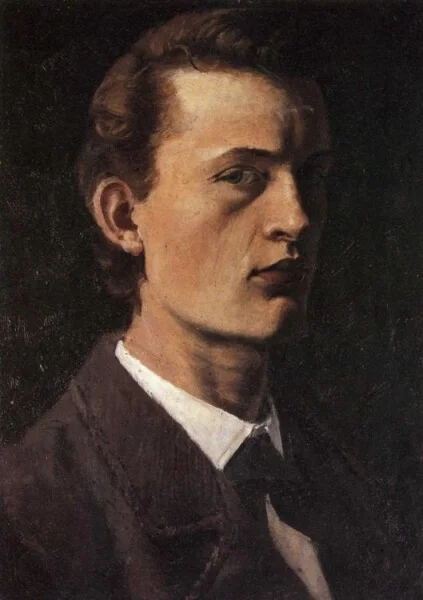Biography of Munch
(December 12, 1863)
Childhood

Self-Portrait. 1881, Oil on Board, 25.5x18.5cm, Munch Museum, Oslo
Born in Loten, Hedmark, on December 12, 1863, Edvard Munch is considered by many to be the greatest of the Norwegian painters, having a profound influence on Expressionist painting, as well as the development of Symbolism in the1890s. The second of five children born to Dr. Christian Munch and his wife Laura Catherine (Bjølstad), Munch’s childhood was marked by poor physical and mental health, both of self and of family members.
The Munch lineage was Norway’s cultural aristocracy, boasting generations of prominent members of academia and clergy. The descendant of Jacob Munch (1776-1838), a well-known painter, and the brother of a distinguished historian, Christian Munch was a military physician and a deeply religious man. Unfortunately, the family tree also carried a susceptibility to tuberculosis, bronchitis and mental illness.
Shortly after the birth of Edvard, Dr. Munch moved his wife and two children, Sophie and Edvard, from Loten to Arkershus in 1864, where siblings Peter, Laura, and Inger were born in 1865, 1867, and 1868, respectively. (At that time, Oslo was known as Christiania; the name was changed to Kristiania in 1877, then to its present name in 1925.) Weakened by the birth of her fifth child, Edvard’s mother died from tuberculoses in 1868, when he was only five years old.Karen Bjølstad, Edvard’s aunt, took on the duties of raising the children; and in 1875, the family moved to Grünerløkka, renting a flat amid the industrial workers and civil servants. Dr. Munch attempted to increase his modest military income by establishing himself in private practice in this new suburb; however, the family continued to be economically challenged due to his soft-heartedness toward patients who were unable to pay, coupled with a poor business sense.
In 1877, Edvard’s older sister Sophie also succumbed to tuberculosis at the age of 15. His younger sister, Laura, was diagnosed with mental illness at an early age. The pervasive infirmities of the children and the loss of both his wife and daughter plunged Dr. Munch into episodes of depression and violent temper, accompanied by the belief that the illnesses and deaths were punishments inflicted upon the family by God.
In 1878, Munch enrolled at the Technical College, where he studied mathematics and physics. His talent in technical drawing propelled him into the fireld of engineering; but in 1880, failing health forced him to leave school. It was at this time that he began to pursue painting. In 1881, Munch was admitted to the Royal Schoool of Art and Design in Kristiania, the teachings of which were primarily rooted in Realism; and it was here he studied scultpure under the direction of Julius Middlethun.